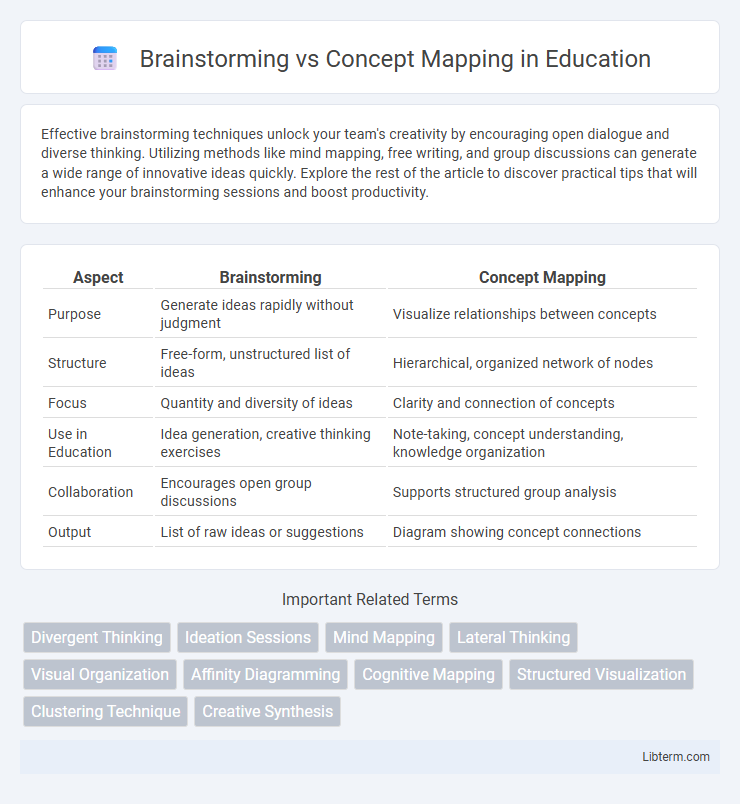Effective brainstorming techniques unlock your team's creativity by encouraging open dialogue and diverse thinking. Utilizing methods like mind mapping, free writing, and group discussions can generate a wide range of innovative ideas quickly. Explore the rest of the article to discover practical tips that will enhance your brainstorming sessions and boost productivity.
Table of Comparison
| Aspect | Brainstorming | Concept Mapping |
|---|---|---|
| Purpose | Generate ideas rapidly without judgment | Visualize relationships between concepts |
| Structure | Free-form, unstructured list of ideas | Hierarchical, organized network of nodes |
| Focus | Quantity and diversity of ideas | Clarity and connection of concepts |
| Use in Education | Idea generation, creative thinking exercises | Note-taking, concept understanding, knowledge organization |
| Collaboration | Encourages open group discussions | Supports structured group analysis |
| Output | List of raw ideas or suggestions | Diagram showing concept connections |
Introduction to Brainstorming and Concept Mapping
Brainstorming is a creative technique used to generate a wide range of ideas quickly by encouraging open and spontaneous thinking within a group or individual setting. Concept mapping organizes these ideas visually by depicting relationships between concepts through nodes and connecting lines, enhancing comprehension and knowledge retention. Both methods complement each other in problem-solving and learning by fostering idea generation and structured understanding.
Defining Brainstorming
Brainstorming is a creative problem-solving technique that involves generating a wide range of ideas quickly without immediate evaluation, fostering open and free thinking. It encourages spontaneous contributions from participants to explore multiple perspectives and solutions. Unlike concept mapping, which organizes and visually represents relationships between ideas, brainstorming prioritizes idea generation over structure.
Understanding Concept Mapping
Concept mapping visually organizes knowledge by connecting ideas with labeled links, enhancing comprehension and retention of complex subjects. Unlike brainstorming, which generates a broad range of ideas rapidly without structure, concept mapping emphasizes relationships and hierarchy among concepts. This method facilitates deeper learning by clarifying connections and promoting critical thinking in educational and professional contexts.
Key Differences Between Brainstorming and Concept Mapping
Brainstorming generates a wide range of ideas rapidly without initial judgment, emphasizing quantity and free-flowing creativity. Concept mapping organizes and visualizes connections between ideas, highlighting relationships and hierarchies to improve understanding. Brainstorming is ideal for idea generation, while concept mapping aids in structuring and analyzing information.
Advantages of Brainstorming
Brainstorming enhances creative thinking by encouraging the free flow of ideas without judgment, fostering a wide range of innovative solutions. It boosts team collaboration and communication, enabling diverse perspectives to emerge quickly. This method is highly flexible, adaptable to various group sizes and topics, making it ideal for generating numerous ideas in a short time frame.
Benefits of Concept Mapping
Concept mapping enhances clarity by visually organizing complex ideas and relationships, making it easier to identify connections and gaps in knowledge. It supports deeper learning and retention through structured representation of information, aiding in problem-solving and critical thinking. Concept maps facilitate collaboration by allowing teams to collectively build and refine models that capture diverse perspectives.
When to Use Brainstorming vs Concept Mapping
Brainstorming is ideal for generating a wide range of ideas quickly during the initial stages of problem-solving or project planning, encouraging free-flowing creativity without judgment. Concept mapping is more effective when organizing and visually structuring complex information, helping to identify relationships and hierarchies among key concepts. Use brainstorming to spark diverse thought and concept mapping to clarify and connect ideas for deeper understanding.
Common Challenges in Brainstorming and Concept Mapping
Common challenges in brainstorming include idea overload, lack of focus, and groupthink, which can hinder creativity and productivity. Concept mapping often faces difficulties such as unclear connections between concepts, oversimplification, and difficulty in organizing complex information. Both methods require structured facilitation to maximize effectiveness and ensure clear, actionable outputs.
Tools and Techniques for Effective Ideation
Brainstorming leverages free-flowing idea generation techniques such as mind dumps, word association, and rapid listing to spark creativity, often supported by digital tools like Miro or Stormboard for collaborative sessions. Concept mapping employs structured visual diagrams that represent relationships between ideas, using software such as CmapTools or Lucidchart to organize complex information hierarchically and identify key connections. Combining these approaches with interactive platforms enhances ideation by facilitating both spontaneous creativity and systematic thought development.
Conclusion: Choosing the Right Method for Idea Generation
Selecting the appropriate technique for idea generation depends on the project's goals and team dynamics. Brainstorming excels in generating a wide range of ideas quickly and encourages free-flowing creativity among participants. Concept mapping is ideal for organizing complex information and visually establishing relationships between ideas, enhancing clarity and structured thinking.
Brainstorming Infographic

 libterm.com
libterm.com